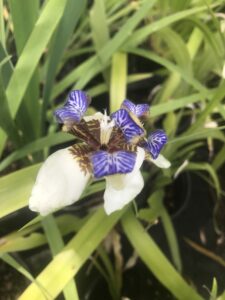S & J Nursery’s Guide to Growing
Walking Iris
in our Northeast Florida Landscape
( Neomarica)
 Walking Iris / Neomarica sp. Origins :
Walking Iris / Neomarica sp. Origins :
– Strongly upright foliage topped with white and purple blooms each year
in early summer. Although Walking Iris can be frost tender in some of our Northeast Florida landscape settings,
these tender perennial plants can remain completely evergreen throughout the winter in others.
Unlike so many other members of the Iris family that grow so well in other parts of the country but fail to thrive through our hot summer months, Walking Iris loves the heat. Native to Brazil, Neomarcia can take all the rain and humidity our semitropical climate zone will give it.
– Sometimes referred to as Apostle Iris, Walking Iris
gets its name from the plantlets that will form at the top of the flower
stalks and bend over with the weight of the newly forming plant until they eventually touch the ground where they will root and grow another plant effectually “walking” across the landscaped area. These new baby plants can easily be pulled up and replanted anywhere you like!
Preferred Exposure of the Walking Iris / Neomaica :
– Walking Iris can be planted in full sun to full shade in just about any type
of garden you can think of.
Foliage on the Walking Iris / Neomarica Plant:
– Glossy green sword-like foliage stands erect in clumps and adds an
instant tropical feel to the garden or landscape.
Soil Preference / Salt tolerance of the Walking Iris / Neomarica :
– Walking Iris prefers rich moist soils and can tolerate a fair amount of standing water after heavy rains or soils that are continuously moist.
– When planted in full sun in well drianed soils plants may need supplemental irrigation to perform at their best
– Unknown salt tolerance.
Walking Iris Size Variance:
– Can grow up to 2+ ft High and 2 ft wide although most often seen rowing
at heights of 2-3 feet.
Walking Iris Growth Habit:
– Evergreen, upright swordlike or lancelike foliage, clump forming
perennial.
– Plants should be dug and divided every 2 – 5 years in early spring for best
flowering.
Growth Rate:
– Walking Iris is a moderate to fast growing perennial plant.
Bloom:
– Beautiful white blooms with a purple center leaves are reminiscent of an
orchid flower and are sometimes sold under the name poor mans orchid. Although short lived, only flowering for a few weeks during the year, the blooming plants especially when planted in mass are stunning
displays of natural beauty.
Walking Iris Water Requirements:
– Walking Iris plants although moderately drought tolerant once established in the landscape, will require regular water to get the plant rooted and growing on it’s own after being planted in the ground from an S & J nursery container. Use supplemental irrigation biweekly when planted in a shady
location that may recieve full sun for a portion of the day rather than filtered light throughout the day that would be more hospitable or in well draining sandy soils for best flowering.
Best Uses For Walking Iris Plants in the North Florida | Jacksonville | St. Augustine area Land cape:
– Walking Iris plants are at home in any garden setting.
– Walking Iris make excellent potted plants and their strongly erect
foliage adds a dramatic flare anywhere they are placed. I love to see them near patios, pools or walkways where the gorgeous blossoms can be appreciated up close and the strong upright foliage blends beautifully with other flowering perennials in mixed plantings.
– Perfect in masses under larger trees or landscape specimen plant you want to draw attention to like a birdbath or statue. Massed plantings of Iris will instantly turn a drab tucked away corner of the yard into a landscape showpiece.
– Great Pondside plant selection.
– Low maintenance landscape selection.
– Fire resistant
Care of Walking Iris plants:
– Water every day during the establishment period after planting in the garden from an S & J Nursery container.
– When planted in location that receives some direct sun or well
drained sandy soils, supplemental irrigation is preferred for maximum flowering.
– As with all perennial plantings, amending the soil with compost when planting your Walking Iris plants will help keep them healthy and happy through the years.
– Plants should be dug and divided every 2-5 years in the early spring.
– Fertilize each spring with a handful of garden compost or a mixture of Milorganite or Green Edge Fertilizer and a slow release poly coated plant food such as Osmocote or Stay Green general purpose plant food or 10-10-10.

